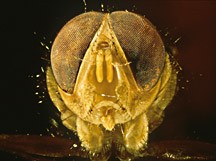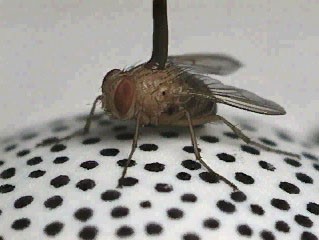Super fly lends an ear to bio-inspired hearing aids and robotic listening devices, Cornell neuroscientists report
By H. Roger Segelken
Cornell University neuroscientists knew they had one amazing fly on their hands when they testedOrmia ochracea, a tiny insect parasite with such acute directional hearing that it has inspired a new generation of hearing aids and nanoscale listening devices.
But it wasn't until the scientists ran an experiment on a fly-sized treadmill that they fully appreciated Ormia's talent for sound localization: Not only can the fly match the species thought to have the best directional hearing – Homo sapiens – but it does so with a fraction of the head space, a boon to miniaturization of man-made devices, Andrew C. Mason, Michael L. Oshinsky and Ron R. Hoy report in the April 5, 2001, issue of Nature .
"We thought humans were the champions at sound localization, thanks to our highly evolved auditory apparatus and the fact that our ears are up to six inches apart, a separation that allows for ample localization cues. Ormia's ears are a minuscule half millimeter apart, but it has evolved a system for localizing sounds very different from any other animal. These latest findings encourage us to continue development of a very small and inexpensive directional hearing aid," says Hoy, a professor of neurobiology and behavior who has studied the parasitic fly for 10 years.
Hoy is a scientific consultant to engineers trying to make a directional hearing aid that would be smaller, simpler and cost thousands of dollars less than currently available devices. Nanoscale listening devices based on the Ormia ear are under development at several industrial and university laboratories, including one at Cornell. Mason was a postdoctoral researcher at Cornell at the time of the fly studies and now is on the faculty of the University of Toronto at Scarborough. Oshinsky was a Cornell graduate student and now is on the research staff of the Jefferson Headache Center, Thomas Jefferson University, Philadelphia. The fly that evildoers wouldn't want on their wall is a specialist at finding the perfect host for its young. In order to reproduce, female flies must perform the same task as female crickets – find a male cricket, Hoy and a postdoctoral researcher, Daniel Robert, first reported inScience in 1992. The female flies possess a unique hearing organ that allows them to detect and locate singing male crickets – where they climb aboard and deposit tiny larvae that develop into larger maggots while feasting on the crickets, from the inside out.
First the flies must locate and home in on the chirping cricket, Hoy notes. But for tactical reasons – "probably to avoid being kicked off," he says – the flies usually land close by and walk the last few steps to their unsuspecting host.
This drop-in and tiptoe maneuver gave the Cornell neuroscientists an idea for an experiment: They rigged a swiveling arm with a small speaker to play recorded cricket sounds. On a Ping-Pong ball they painted hundreds of dots so that the ball's position could be tracked by computer, the same way the movement of a computer mouse is tracked. The ball was floated on a jet of air so that it could easily be turned by a walking fly. Then they placed a tethered fly on the ball, turned on the cricket sounds from the speaker and sat back to see what would happen next.
No matter where the sound was directed, to the right or left of center, the fly altered its path to walk directly toward the cricket chirps. Ormia flies, the biologists discovered, can detect changes in sound-source position as small as 2 degrees. Even humans trying to detect who is speaking in a crowded room can't do better than that.
"When you consider the size difference between humans and flies, Ormia flies are the real champions," Hoy says, describing a mechanical linkage between the fly's closely spaced eardrums as something like a playground teeter-totter, an earlier discovery made in collaboration with postdoctoral researcher Robert and Binghamton University engineer Ronald Miles. Sound waves cause each fly eardrum to beat out of phase with the other.
"The near ear, the one closest to the sound source, responds more vigorously, compared to the far ear, " Hoy explains. Then the fly's nervous system (its fused neural ganglia and a tiny brain) instantaneously calculates the difference in pressure between the two ears and signals the fly's muscles to respond to the sound source. With human ears about 6 inches apart, we have about 10 microseconds to make the same calculation that the Ormia fly, with its half-millimeter head, makes in about 50 nanoseconds – a thousand times faster. Trying to mimic the Ormia ear in silicon, the Cornell and Binghamton University engineering groups so far have developed prototype "microphone eardrums" that function "Ormia -like" as predicted but at ultrasonic frequencies. "This might make a good hearing aid for a bat," Hoy notes, "but we need a device that responds to critical frequencies in the human hearing range, especially in speech – and one that will be highly directional, fit inside the ear canal and be affordable." Other applications of the bio-inspired silicon ear might be in robotic listening devices, he suggests.
"I've been doing basic biological studies of insect hearing systems for over 20 years, and this work [with the Ormia ear] is the first to have a potential application," he says, acknowledging grants from the National Institute on Deafness and Other Communication Disorders (NIDCD). "We have a lot to learn from creatures in the natural world. They have been working on difficult problems much longer than we have."
Commenting on work of the Hoy laboratory, NIDCD Director James Battey Jr. said: "Individuals who use hearing aids often struggle to understand conversation competing with other sounds and noises in the environment. The biological lessons provided by Ormia 's abilities in hyperacute time-coding and localization of sound promise to produce strategies for improved nano- or microscale directional microphones in hearing aids. Applications of these new principles may improve life for individuals with hearing loss who depend upon hearing aids."
Other related websites:
- National Institute on Deafness: http://www.nidcd.nih.gov/
Media Contact
Get Cornell news delivered right to your inbox.
Subscribe
